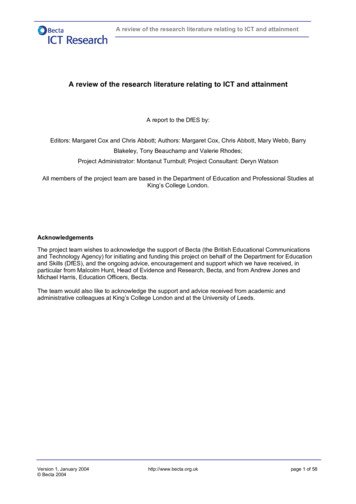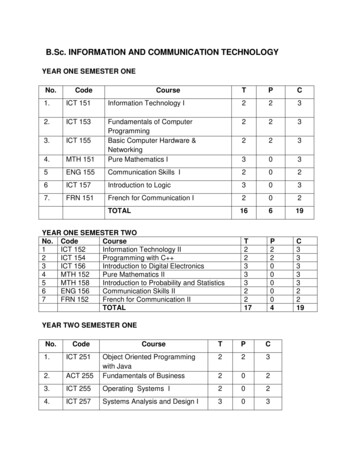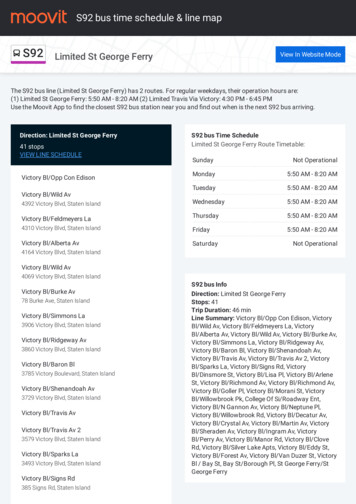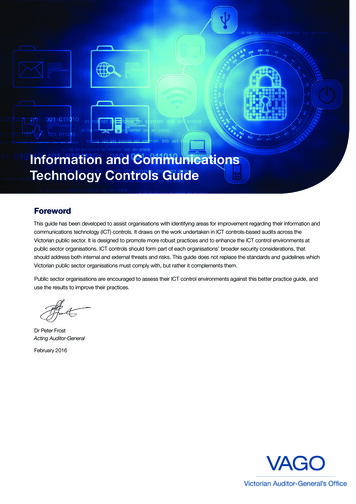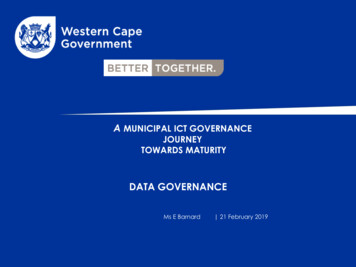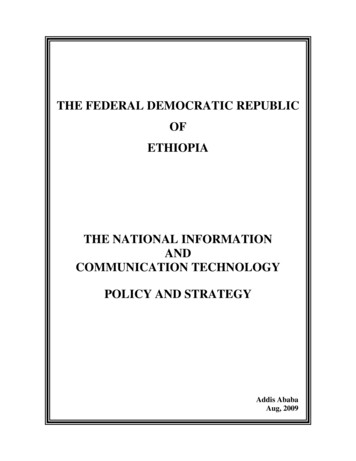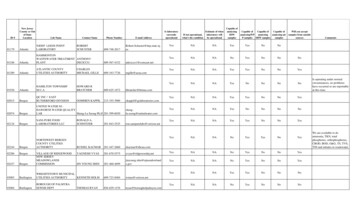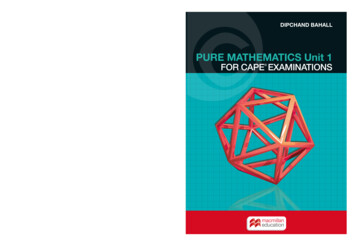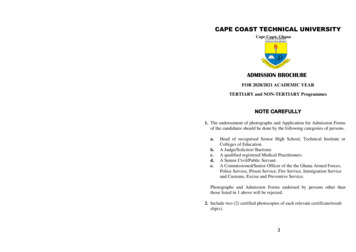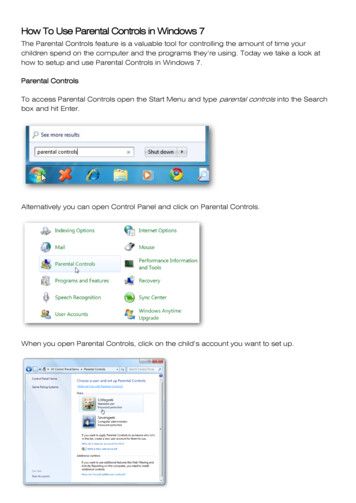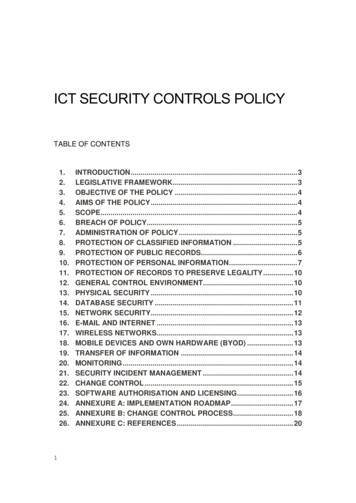
Transcription
ICT SECURITY CONTROLS POLICYTABLE OF 18.19.20.21.22.23.24.25.26.1INTRODUCTION . 3LEGISLATIVE FRAMEWORK . 3OBJECTIVE OF THE POLICY . 4AIMS OF THE POLICY . 4SCOPE. 4BREACH OF POLICY. 5ADMINISTRATION OF POLICY . 5PROTECTION OF CLASSIFIED INFORMATION . 5PROTECTION OF PUBLIC RECORDS. 6PROTECTION OF PERSONAL INFORMATION . 7PROTECTION OF RECORDS TO PRESERVE LEGALITY . 10GENERAL CONTROL ENVIRONMENT. 10PHYSICAL SECURITY . 10DATABASE SECURITY . 11NETWORK SECURITY. 12E-MAIL AND INTERNET . 13WIRELESS NETWORKS. 13MOBILE DEVICES AND OWN HARDWARE (BYOD) . 13TRANSFER OF INFORMATION . 14MONITORING . 14SECURITY INCIDENT MANAGEMENT . 14CHANGE CONTROL . 15SOFTWARE AUTHORISATION AND LICENSING . 16ANNEXURE A: IMPLEMENTATION ROADMAP . 17ANNEXURE B: CHANGE CONTROL PROCESS . 18ANNEXURE C: REFERENCES . 20
Glossary of AbbreviationsAbbreviationDefinitionBYODBring Your Own DeviceCOBITControl Objectives for Information and RelatedTechnologyICTInformation and Communication TechnologyIPInternet ProtocolISOInternational Organization for StandardisationODBCOpen Database ConnectivityPINPersonal Identification NumberSSHSecure ShellUPSUninterrupted Power SupplyUSBUniversal Serial BusWPA2Wi-Fi Protected Access 2Glossary of TerminologiesTerminologyDefinitionAdministrative rightsAccess rights that allow a user to perform highlevel/administrative tasks on a device/applicationsuch as adding users, deleting log files, deletingusers.Biometric informationPersonal information obtained through biometricmeasurements, such as finger prints, retina, DNA,etc.Internalprocesses2system Processes that are performed by the system withno human intervention. Part of the internal workingof the system or application.
1. INTRODUCTIONInformation security is becoming increasingly important to the Municipality, driven in partby changes in the regulatory environment and advances in technology. Informationsecurity ensures that the Municipality’s ICT systems, data and infrastructure areprotected from risks such as unauthorised access (see ICT User Access ManagementPolicy for further detail), manipulation, destruction or loss of data, as well asunauthorised disclosure or incorrect processing of data.2. LEGISLATIVE FRAMEWORKThe policy was drafted bearing in mind the legislative conditions, as well as to leverageinternationally recognised ICT standards.The following legislation, among others, were considered in the drafting of this policy: Constitution of the Republic of South Africa Act, Act No. 108 of 1996. Copyright Act, Act No. 98 of 1978 Electronic Communications and Transactions Act, Act No. 25 of 2002 Minimum Information Security Standards, as approved by Cabinet in 1996 Municipal Finance Management Act, Act No. 56 of 2003 Municipal Structures Act, Act No. 117 of 1998 Municipal Systems Act, Act No. 32, of 2000 National Archives and Record Service of South Africa Act, Act No. 43 of 1996 National Archives Regulations and Guidance Promotion of Access to Information Act, Act No. 2 of 2000 Protection of Personal Information Act, Act No. 4 of 2013 Regulation of Interception of Communications Act, Act No. 70 of 2002 Treasury Regulations for departments, trading entities, constitutional institutionsand public entities, Regulation 17 of 2005.The following internationally recognised ICT standards were leveraged in thedevelopment of this policy:3 Western Cape Municipal InformationGovernance Policy Framework, 2014 Control Objectives for Information Technology (COBIT) 5, 2012 ISO 27002:2013 Information technology — Security techniques — Code ofpractice for information security controlsandCommunicationTechnology
King Code of Governance Principles, 20093. OBJECTIVE OF THE POLICYThe objective of the policy is to reduce the risk of harm that can be caused to theMunicipality’s ICT systems, information and infrastructure. This policy also seeks tooutline the acceptable use of ICT resources by Officials and 3rd party service providers,to ensure that the investment in modern technology is applied to the best advantage ofthe Municipality.This policy defines the collective controls to prevent Information Security related riskfrom hampering the achievement of the Municipality's strategic goals and objectives.4. AIMS OF THE POLICYThe aim of this policy is to ensure that the Municipality conforms to a standard set ofsecurity controls for information security in such a way that it achieves a balancebetween ensuring legislative compliance, best practice controls, service efficiency andthat risks associated to the management of Information Security are mitigated. Thispolicy supports the Municipality's Corporate Governance of ICT Policy.5. SCOPEThis ICT Security Controls Policy has been developed to guide and assist municipalitiesto be aligned with internationally recognised best practice ICT Security Controls. Thispolicy recognizes that municipalities are diverse in nature, and therefore adopts theapproach of establishing and clarifying principles and practices to support and sustainthe effective control of information security.The policy applies to everyone in the Municipality, including its 3rd party serviceproviders and consultants.This policy is regarded as being critical to the security of ICT systems of the Municipality.Municipalities must develop their own Security controls and procedures by adopting theprinciples and practices presented in this policy.The policy covers the following elements of information security: Ownership and classification of information; Security incident management; Physical security; Application security; Network security; Database security; Change control; and4
Software authorisation and licensing.Aspects relating to user access, server security and data backup are covered in the ICTUser Access Management, ICT Operating System Security Controls and the ICT DataBackup and Recovery policies.6. BREACH OF POLICYAny failure to comply with the rules and standards set out herein will be regarded asmisconduct and/or breach of contract. All misconduct and/or breach of contract will beassessed by the Municipality and evaluated on its level of severity. The appropriatedisciplinary action or punitive recourse will be instituted against any user whocontravenes this policy. Actions include, but are not limited to: Revocation of access to Municipal systems and ICT services; Disciplinary action in accordance with the Municipal policy; or Civil or criminal penalties e.g. violations of the Copyright Act, 1978 (Act No. 98 of1978). Punitive recourse against a service provider in terms of the contract.7. ADMINISTRATION OF POLICYThe ICT Manager or delegated authority is responsible for maintaining the policy. Thepolicy must be reviewed by the ICT Steering Committee on an annual basis and anychanges approved by Council.8. PROTECTION OF CLASSIFIED INFORMATION8.1The Municipal Systems Act, Act No. 32 of 2000, Schedule 1: Code of Conductfor Councillors and Schedule 2: Code of Conduct for Municipal Staff Membersrequire Councillors and Officials to employ a strict level of self-discipline in orderto prevent communication of sensitive or classified information. Councillors andOfficials may not disclose any privileged or confidential information to anunauthorised person.8.2All Municipal data must be classified in accordance with the MinimumInformation Security Standards, as approved by Cabinet in 1996. Therefore allofficial matters requiring the application of security measures must be classifiedeither as "Restricted" or "Confidential”. By default, Municipal data has beenclassified as ormation that may be used to hamper Municipalactivities.
ClassificationDescriptionConfidentialInformation that may be used harm the objectives andfunctions of the Municipality.Table 1: Data classification in accordance with the MISS8.3Access to classified information is determined either by the level of securityclearance, or if the information is required in the execution of their duties.8.4Officials, in conjunction with the ICT Manager, must ensure that classifiedinformation receives adequate protection to prevent compromise.8.5Officials who generate sensitive information are responsible for determining theinformation classification levels. This responsibility includes the labelling ofclassified documents.8.6The Minimum Information Security Standards Chapter 6, Section 1 requires thata declaration of secrecy must be made on an official form during the appointmentprocess for any government post.9. PROTECTION OF PUBLIC RECORDS9.1The National Archives and Records Service of South Africa Act, Act 43 of 1996requires sound records management principles to be applied to electronicrecords and e-mails created or received in the course of official business andwhich are kept as evidence of the Municipality’s functions, activities andtransactions. The detail of these requirements can be found in:(a)The [Records Management Policy], [Internet and e-Mail Usage], [WebContent Management Policy] and [Document Imaging Policy] of theMunicipality; and(b)The National Archives and Records Service of South Africa Regulations.9.2The Records Manager is responsible for the implementation of sound recordsmanagement principles and record disposal schedules for the Municipality.9.3The ICT Manager must work with the Records Manager to ensure that publicrecords in electronic form are managed, protected and retained for as long asthey are required.9.4Information security plays an important role in records management as a meansto protect the integrity and confidentiality of public records. The ICT Managermust ensure that systems used for records management of electronic publicrecords and e-mails are configured and managed as follows:6(a)Systems must capture appropriate metadata (background and technicalinformation about the data);(b)The systems must establish an audit trail to log all attempts to alter or editelectronic records and their metadata;
(c)The system must protect the integrity of records until they have reachedtheir approved retention. Integrity of records can be accomplished throughprocedures such as backup test restores, media testing, data migrationcontrols and capturing the required audit trails;(d)Access controls must protect records against unauthorized access andtampering;(e)Access controls must prevent removal of data from premises without theexplicit permission of the ICT Manager;(f)Systems must be free from viruses;(g)The system must ensure that electronic records, that have to be legallyadmissible in court and carry evidential weight, are protected to ensurethat they are authentic, not altered or tampered with, auditable andproduced in systems which utilise security measures to ensure theirintegrity.(h)Access to server rooms and storage areas for electronic records mediamust be restricted to ICT staff with specific duties regarding themaintenance of the hardware, software and media.(i)Systems technical manuals and systems procedures manuals must bedesigned for each system.(j)A systems technical manual include information regarding the hardware,software and network elements that comprise the electronic recordkeeping system and how they interact. Details of all changes to a systemmust also be documented.(k)A system procedures manual include all procedures relating to theoperation and use of the system, including input to, operation of and outputfrom the system. A systems procedures manual should be updated whennew releases force new procedures.(l)The ICT Manager must ensure that the suitability of new system forrecords management are assessed during its design phase. The RecordsManager must be involved during the design specification.10. PROTECTION OF PERSONAL INFORMATION10.1The Bill of Rights in the Constitution states that the public has a right to privacy,as well as a right to access personal information held by the Municipality.10.2The Promotion of Access to Information Act, Act No. 2 of 2000, gives effect tothe right to access personal information held by the Municipality and must becomplied with.10.3The Protection of Personal Information Act, Act No. 4 of 2013, gives effect to theright to privacy. The Act requires that the Information Officer of the Municipalityensure that personal information are lawfully obtained and processed.7
10.4The ICT Manager and Officials must work together to ensure the following withrespect to personal information (only key points of the Act included):(a)Identify the systems and locations where personal information can befound;(b)Ensure that Municipal policies, in particular those that deal with informationsecurity, are applied to the systems and locations where personalinformation is collected, processed and disposed of;(c)Put in place business process controls to ensure that personal informationare collected lawfully, is complete and accurate, and updated wherenecessary;(d)Dispose of excessive personal information, after consultation with theRecords Manager;(e)Put in place structures and systems to allow the access of persons to theirpersonal information stored by the Municipality. Therequestermayrequest to have their personal information deleted or corrected if it isincorrect or obtained unlawfully; and(f)Ensure that systems do not use personal information as the sole basis todecide legal consequences for a person or group of persons (referred toas “automated decision making”).10.5The Protection of Personal Information Act, No. 4 of 2013, Section 6, containscertain general exceptions where the Act does not apply e.g. the processing ofpersonal information for national security, defence, public safety, lawenforcement or for the judicial functions of a court.10.6The Protection of Personal Information Act, No. 4 of 2013 prohibits theprocessing of certain categories of special personal information. The generalexception is where a competent person (e.g. in the case of children) have givenconsent, or if an exception apply. Examples are shown hereunder (refer to theAct for further detail):SectionsSpecialpersonal Collectionandprocessingprohibited unless exceptionsinformationapply. Examples of exceptionsprovided:Sections 6, 34 to 37Children’s informationSections 6 & 28Religiousor To protect the spiritual welfare of aphilosophical beliefscommunity.Sections 6 & 29Race or ethnic origin8Establishment or protection of a rightof the child.Protection from unfair discriminationor promoting the advancement ofpersons.
SectionsSpecialpersonal Collectionandprocessingprohibited unless exceptionsinformationapply. Examples of exceptionsprovided:Sections 6 & 30TrademembershipSections 6 & 31Political persuasionTo achieve the aims of a politicalinstitution that the person belongs to.Sections 6 & 32Health or sex lifeProvision of healthcare services,special support for pupils in schools,childcare or support for workers.Sections 6 & 33Criminal behaviour or Necessary for law enforcement.biometric informationunion To achieve the aims of trade unionthat the person belongs to.Figure1:SpecialpersonalProtection of Personal Information Act, No. 4 of 201310.7informationprotectedbytheThe following personal information are not regarded as special personalinformation and must be protected in terms of the general rules for the protectionofpersonalinformation:Gender, sex, marital status, age, culture, language, birth, education, financial,employment history, identifying number, symbol, e-mail address, physicaladdress, telephone number, location, online identifier, personal opinions, views,preferences, private correspondence, views or opinions about a person, or thename of the person if the name appears next to other personal information or ifthe name itself would reveal personal information about the person.10.89The Promotion of Access to Information Act, Act No. 2 of 2000, prohibits thedisclosure of certain types of information held by the Municipality, including, butnot limited to personal information. These include: Commercial information of a third party; Information that falls under a confidentiality agreement; Information that is likely to endanger the safety of individuals if it is madepublic; Police dockets in bail proceedings; Records privileged from production in legal proceedings; Research information of a third party; Security information about a building, structure or system; Methods, techniques, procedures or guidelines for law enforcement andlegal proceedings; Information that will prejudice the defence, security and internationalrelations of the Republic;
10.9 Information that will jeopardise the economic interests and financial welfareof the Republic and commercial activities of the Municipality; Research information of the Municipality; and Information about the operations of the Municipality.The Promotion of Access to Information Act, Act No. 2 of 2000, require thatinformation relating to public safety, environmental risk, or a substantialcontravention of, or failure to comply with the law, be disclosed immediately.11. PROTECTION OF RECORDS TO PRESERVE LEGALITY11.1The Electronic Communications and Transactions Act, Act. No. 25 of 2002,prescribes information security controls to preserve the evidential weight ofelectronic records and e-mails.11.2The evidential weight of electronic records and e-mails is a continuum, wherethe weight of the evidence increases with the number of information securitycontrols applied. The following lists examples of such specific informationsecurity controls: Restrict access to records Encrypt records Store records on write once, read many times, media Apply records management principles Store records in a database management system Apply change control to the records management system Backup data Use digital certificates to confirm the identities of senders andreceivers of messages12. GENERAL CONTROL ENVIRONMENT12.1To ensure reliability of ICT services and to comply with legislation, all Municipalsystems and infrastructure must be protected with physical and logical securitymeasures to prevent unauthorised access to Municipal data.12.2Physical and logical security is a layered approach that extends to user access,application security, physical security, database security, operating systemsecurity and network security.12.3Refer to the ICT User Access Management Policy and the ICT Operating SystemSecurity Controls Policy for the requirements relating to user access,applications and operating system security.13. PHYSICAL SECURITY10
13.1The ICT Manager must take reasonable steps to protect all ICT hardware fromnatural and man-made disasters to avoid loss and ensure reliable ICT servicedelivery. ICT hardware under control of the ICT function must be hosted inserver rooms or lockable cabinets. Server rooms must be of solid constructionand locked at all times.13.2The ICT department must retain an access control list for the server room.Access must be reviewed quarterly by the ICT Manager.13.3All server rooms must be equipped with air-conditioning, UPS and fire detectionand suppression.13.4A maintenance schedule must be created and maintained for all ICT hardwareunder the control of the ICT department. Maintenance activities must berecorded in a maintenance register.13.5Server rooms must be kept clean to avoid damage to hardware and reduce therisk of fire.13.6Cabling must be neat and protected from damage and interference.13.7No ICT equipment may be removed from the server room or offices without priorauthorisation from the ICT Manager.13.8Officials of the Municipality must be made aware of the acceptable use of ICThardware.13.9All hardware owned by the Municipality must be returned by employees andservice providers when no longer needed or on termination of their contract.13.10 All data and software on hardware must be erased prior to disposal or re-use.13.11 Any hardware that carry data that can be carried off-site (e.g. laptop computers,removable hard disks, flash drives etc.) must be protected with encryption.13.12 ICT hardware and software must be standardised as far as possible to promotefast, reliable and cost-effective ICT service delivery to the Municipality.13.13 The off-site location, used to store backup data media, must be protected withthe following physical security measures: Building of solid construction; Physical access control; Fire detection and suppression; and Environmental conditions adhere to vendor recommendations for storageof media.14. DATABASE SECURITY11
14.1The ICT Manager must limit full access to databases (e.g. sysadmin server role,db owner database role, sa built-in login etc.) to ICT staff who need this access.Officials who use applications may not have these rights to the application'sdatabases.14.2The ICT Manager must ensure that Officials who access databases directly (e.g.through ODBC) only have read access.14.3The ICT Steering Committee must approve all instances where Officials haveedit or execute access to databases.14.4The ICT Manager must review database rights and permissions on a quarterlybasis. Excessive rights and permissions must be removed.15. NETWORK SECURITY15.1The ICT Manager must document the network structure and configurationincluding IP addresses, location, make and model of all hubs, switches, routersand firewalls.15.2The ICT Manager must implement a firewall between the Municipal network andother networks.15.3The ICT Manager must limit administrator access to the firewall and useraccounts must have strong passwords of at least 8 characters with acombination of alpha-numeric characters and symbols. Remote firewalladministration is only allowed using SSHv2 from the internal network.15.4The ICT Manager must check and install firewall upgrades and patches on aweekly basis. An obsolete firewall (one that is not supported by the vendor anylonger and / or has known security vulnerabilities) must be replaced.15.5The ICT Manager must document the firewall rulesets and configuration settings.The rulesets and configuration settings must be reviewed quarterly to ensurethat it remains current (i.e. remove unused services) and that services thatexpose the Municipality to security risk are reviewed continuously.15.6The ICT Manager must configure the firewall to block all incoming ports, unlessthe service is required to connect to a server on the internal network (e.g. port80 and port 443 for web servers). When an incoming port is allowed, the servicemay only connect to the specific servers on the internal network. Internal IPaddresses may not be visible outside of the internal network.15.7The ICT Steering Committee must approve all open incoming ports. The ICTSteering Committee must only approve requests that are absolutely necessaryand with consideration of the associated security risks.15.8The system administrators must set the firewall to block intrusion attempts andto alert the ICT Manager when additional action needs to be taken. The ICTManager must raise an incident and deal with the root causes of the event.12
15.9The ICT Manager must place infrastructure, user devices (e.g. personalcomputers) and servers facing externally on separate network domains.15.10 The ICT department must scan the entire network with security software on amonthly basis to detect security vulnerabilities. The scans must be performedfrom the Internet, as well as from the internal network.15.11 Officials and the ICT Manager must remove all modems from the internalnetwork to avoid intruders bypassing the firewall.15.12 System administrators must install personal firewalls on laptops and personalcomputers. Officials may not disable these firewalls. Officials must choose todeny a specific address when prompted by the personal firewall, unlessapproved by ICT.15.13 The ICT department must ensure that all inactive network points are disabled.16. E-MAIL AND INTERNET16.1The ICT Manager must make all users aware of the safe and responsible use ofe-mail and Internet services. E-mail and Internet should only be used for officialuse. Personal usage can be permitted if it does not interfere with job functions.E-mail and Internet may not be used for any illegal or offensive activities.16.2Officials and the ICT department may not use Internet cloud services (e.g.Google drive, Gmail, Dropbox etc.) for official purposes unless approved by theICT Steering Committee.17. WIRELESS NETWORKS17.117.2System administrators must configure all wireless networks to the followingstandard: WPA2 security protocol or better; Password strength of at least 8 characters with a combination of alphanumeric characters and symbols; The latest firmware must be installed; and Default system usernames and passwords must be removed.Officials may not establish wireless networks attached to the internal networkwithout the consent of the ICT Manager. All wireless networks must adhere tothe secure configuration standard.18. MOBILE DEVICES AND OWN HARDWARE (BYOD)18.113The ICT Manager must approve all hardware and software, owned by Officialsand service providers, which is to be used for official purposes.
18.2The ICT team must ensure that all mobile devices must be protected with a PIN.19. TRANSFER OF INFORMATION19.1The ICT Manager must ensure that classified information may only betransmitted over external networks using encryption.19.2Officials may not use personal storage devices (e.g. USB memory sticks orportable hard drives) to store Municipal data. When required for official purposes,and the data is of a confidential nature, these devices must be encrypted by theICT Manager.20. MONITORING20.1The Municipal Manager authorises the monitoring of Municipal systems by theICT Manager.20.2Municipal officials must be made aware that the network is being monitored toensure network security, to track the performance of the network and systems,and to protect the network from viruses.20.3If users give their written consent, any e-mail, Internet and other network servicemay be monitored. A signed acceptable user agreement is required in order toachieve this consent.21. SECURITY INCIDENT MANAGEMENT21.1All Municipal users must report actual or suspected security breaches or securityweaknesses to the ICT Manager or the delegated authority.21.2The ICT Manager must record all information regarding security incidents. TheICT Manager must review all the information security incidents on a quarterlybasis to ensure that the root cause of the problems are addressed.21.3Investigations into security incidents may only be carried out by the ICT Manageror a nominated person.21.4The Protection of Personal Information Act, Act No. 4 of 2013 prescribe that theRegular and the person affected by the breach must be notified in the event of abreach of personal information.14
22. CHANGE CONTROL22.1All changes to Municipal applications and infrastructure must be managed in acontrolled manner to ensure fast and reliable ICT service delivery to theMunicipality, without impacting the stability and integrity of the changedenvironment.(a)Corrections, enhancements and new capabilities for applications andinfrastructure will follow a structured change control process.(b)An emergency change must follow a structured change control process,but with the understanding that documentation must be completedafterwards. Emergency changes are only reserved for fixing errors in theproduction environment that cannot wait for more than 48 hours.(c)Recurring change requests from users (e.g. user access requests, apassword reset, an installation, move or change of hardware and softwareetc.) must follow the help-desk processes designed to deliver ICT servicesin the most effective way.(d)Recurring operational tasks are excluded from the structured changecontrol process.22.2The ICT Manager must establish the formal change control process. ReferAppendix B, Change Control Process.22.3The following additional rules with respect to change control must be adheredto. In some cases this may not be cost-effective or technically possible, in whichcase it is the duty of the ICT Steering Committee to review and approvealternative controls:15(a)The same person who performs the change may not implement thechange.(b)Systems must have a development environment where testing isconducted to avoid testing in the production environment.(c)If a vendor performs the change, the Municipality must also test thechange.(d)The data inside a database may not be edited, except through an approvedapplication front-end. This exclu
security controls for information security in such a way that it achieves a balance between ensuring legislative compliance, best practice controls, service efficiency and that risks associated to the management of Information Security are mitigated. This policy supports the Municipality's Corporate Governance of ICT Policy. 5. SCOPE
